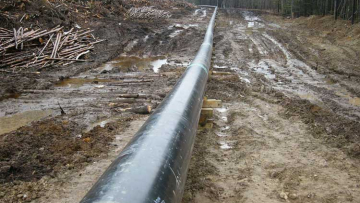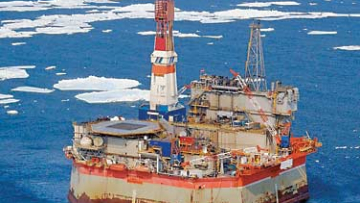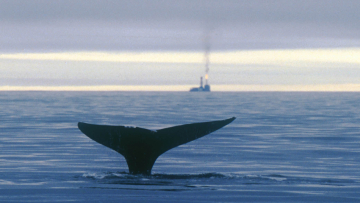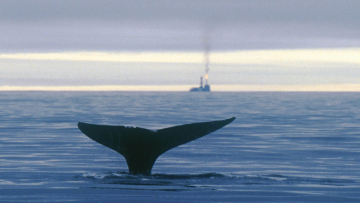Project – On record
This profile is no longer actively maintained, with the information now possibly out of dateBankTrack
Doug Norlen, Pacific Environment, United States
Project – On record
This profile is no longer actively maintained, with the information now possibly out of dateBankTrack
Doug Norlen, Pacific Environment, United States
What must happen
The project should not receive funding from any bank claiming to apply the Equator Principles or equivalent standards. Any such endorsement would send a signal that lower standards are acceptable for the sector and for other operators on Sakhalin Island and elsewhere.
| Sectors | Oil and Gas Extraction |
| Location |
|
|
|
This project has been identified as an Equator Project |
The Sakhalin II project in the Russian Far East is said by project sponsors to be the largest integrated oil and gas project in the world. The project involves three offshore oil and gas platforms and subsea pipelines to shore. The oil and gas is then transported via 800 km of onshore pipelines to one of the world’s largest natural gas liquefaction and export terminal and oil export facilities at Prigorodnoye, in the south of Sakhalin. Oil and liquid natural gas is then exported via tankers.
Environmental and climate impacts
Sakhalin Energy Investment Company (SEIC) has installed two of its new oil and gas platforms adjacent to the only known feeding ground of the approximately 130 critically endangered Western Gray Whales. After initially planning to build a subsea oil pipeline directly through the whale’s feeding area, SEIC re-directed the offshore pipeline just adjacent to the feeding area, continuing to threaten the population with its far-reaching impact. Noise, collisions, and sediment disturbance put the whales at risk during construction. The whales will face an ongoing risk of an oil spill in this harsh environment. The sea around the platform is covered by ice for 6 months of the year, seriously limiting the ability of SEIC to respond to an oil spill. Despite unreasonably optimistic promises by SEIC, there is no proven effective way to respond to oil spills in ice conditions.
Shell has not followed the precautionary approach, refusing to deviate from its construction schedule to wait for the completion of scientific analysis and it refuses to follow much of the advice from a panel of whale experts hosted by the International Union for the Conservation of Nature. As a result, the decision of whether the oil platforms should be constructed at all in the area of the critically endangered Western Gray Whale became moot issues for the panel. The whale scientists also made recommendations on noise limits, which SEIC has violated on several occasions.
SEIC built over 1000 pipeline river crossings, which has led to damage to salmon spawning rivers. SEIC has failed to construct 800 kilometers of parallel on-shore oil and gas pipelines simultaneously to reduce impact. Ineffective erosion control, unapproved stream diversion and sedimentation of rivers have damaged hundreds of salmon spawning rivers and tributaries. SEIC has revised its river crossings strategy but has failed to comply with the requirements of this strategy on a high percentage of sensitive rivers. Meanwhile, SEIC's pipeline design has failed to account for geohazards and river migration features of Sakhalin that will result in risks extending throughout the life of the project. NGO monitoring in October and December 2007 continued to find non-compliance with the required river-crossing and soil erosion management plans, raising concerns over the integrity of the pipeline system, especially in areas prone to seismic zones and landslides.
SEIC constructed one of the world’s largest liquid natural gas plant in the south of the island in Aniva Bay. In so doing, SEIC dredged the bay to deepen the access for tankers, and dumped the dredged materials in the middle of this fisheries-rich bay, refusing to dump the material in a less environmentally harmful location further out to sea. Fisheries have been disrupted, and SEIC did not accurately predict the impact on the bay ecosystem. SEIC did not adequately consult on the construction of a jetty in Aniva as required by Russian EIA law. The local shellfish beds suffered from damage from dumping of dredged material.
The LNG facility, combines with LNG and oil export terminals comprise the Pregorodnoye Production Complex, the construction and operation of which has caused degredation of air quality, noise disturbance, damage and loss of access to local fishing and recreation resources, declines in agricultural productivity and decreases in community and road safety, and loss of land value for local dacha owners. Despite this displacement, SEIC has not resettled dacha owners in compliance with Russian law, international finance institution policies, and corporate committments.
In October, 2007, SEIC announced that a new consultant report for potential lenders gives the project a "clean bill of health." However, this report actually reveals amongst other things systematic and chronic violations of policies and standards of potential international lenders and, by extension, the Equator Principles. An NGO critique of this report is available in the 'documents' section of this profile.
The construction and operation of the Sakhalin II Prigorodnoye Complex has caused pollution and physical damage to the Stroitel Association’s dachas and to their cultivated lands, which are located within the Complex’s Sanitary Defense Zone as approved by the Russian Ministry of Natural Resources.
Applicable norms and standards
Sakhalin-II pipelines
2011 Goldman Prize for Asia: Dmitry Lisitsyn, Russia
Sakhalins Black Tears - Part 2
Sakhalins Black Tears - Part 1
Video links
2012
2012-02-01 00:00:00 | WWF Campaign Against Sakhalin
In February 2012 WWF initiated a campaign advocating the protection of the gray whale by floating a replica of a 33 foot long gray whale on the Thames River in London. WWF is protesting against the Sakhalin oil and gas project in Russia. Sakhalin Energy Investment Company is planning to build a third rig in the area; this additional rig was not taken into account in the original environmental impact assessment. Environmentalists are worried that the construction of this rig will further push the gray whale toward extinction.
It is hoped that the campaign will get the attention of project lenders such as Credit Suisse, BNP Paribas, and Standard Chartered and that they do not support the financing of an additional rig.
For more information please click here.
2008
2008-07-18 00:00:00 | Latest update
The project is subject to various investigations by the Russian Authorities. The Russian Ministry of Natural Resources has found violations relating to protected forest being felled, water code violations associated with river and other damage, and risks of landslides. These findings confirm the problems documented by NGOs over recent years.
The Russian Audit Office has investigated the huge cost increases on the project (from $10 billion to $ 22 billion so far), which decrease and delay the revenue stream to the Russian government under the Production Sharing Agreement. The project is now built, and has caused damage to salmon spawning rivers and exposed endangered gray whales to excessive noise, potential ship strikes and pollution. The fisheries in Aniva have suffered and indigenous people and local communities have not been adequately consulted. Any investor will inherit the problems that have been built-in to the project, and cannot ignore the numerous breaches of the Equator Principles that have already occurred. Going forward the project suffers from inadequate measures to respond to oil spills in ice conditions. There are no proven response techniques that can give response all year round. Despite its remote location, the project has received significant coverage in the international media of the environmental and social problems and presents a significant reputational risk. Any finance institution involved in the project risks being held responsible for potential extinction, along with other long-term damage to the environment and local economy and communities.





